Items tagged with 'rpi'
Daniel Libeskind at RPI

Daniel Libeskind. / photo: Stefan Ruiz
The RPI School of Architecture's fall lecture series has started up and it includes a talk by famed architect Daniel Libeskind November 12 at EMPAC.
The full lecture series schedule -- which started in September -- is listed below.
Daniel Libeskind's Studio Libeskind has designed notable buildings all around the world, many of them museums, including the Jewish Museum Berlin. Its most famous work might be the master plan for the World Trade Center site in Manhattan. That plan -- and the design of the Freedom Tower skyscraper, which Libeskind did not create -- ended up being a contentious process, prompting protests (and a lawsuit) by the Libeskind about how things played out. In recent years he has apparently come around on the experience and now sees it -- and the results -- more positively.
Liebskind's talk at RPI is titled "Edge of Order," the same name as a new book about his career that's being published in November.
The talk is Monday, November 12 at 6 pm at EMPAC. It's free.
RPI Commencement Colloquy 2018

Herbie Hancock, Mary Jo White, Eric Lander, Alicia Boler Davis
RPI's commencement events this year will again include a colloquy -- a conversation -- with the people getting honorary degrees. The public event is next Friday, May 18. The lineup:
Herbie Hancock, the legendary jazz pianist and composer, has brought forth innovations in jazz and combined a passion for engineering and science with music.
Mary Jo White, former chair of the United States Securities and Exchange Commission and senior chair at the law firm Debevoise & Plimpton, oversaw major prosecutions of international terrorists and white-collar crime.
Dr. Eric Lander, president of the Broad Institute of MIT and Harvard, is a leading authority on genomic science, which has opened the door for groundbreaking innovations in disease diagnosis and treatment.
Rensselaer alumna Alicia Boler Davis '98, executive vice president of General Motors Global Manufacturing, is one of the most powerful women in automotive manufacturing.
They'll be talking on stage with RPI president Shirley Ann Jackson.
The discussion is Friday, May 18 at 3:30 pm in the concert hall at EMPAC. It's free and open to the public, but RPI does ask that people pre-register (see the link above). It will also be live streamed
Cecile Richards
This year's Sage commencement speaker is Cecile Richards, former president of Planned Parenthood. And she'll be at Market Block Books in Troy this Saturday, May 12, for a book signing from 3:30-5:15 pm.
The Sage commencement will be live streamed.
GameFest 2018
One of the creators of the narrative game What Remains of Edith Finch will be giving this year's keynote.
The annual GameFest returns to downtown Troy and RPI this Saturday, May 5. It's a showcase of digital games and chance to talk about issues that intersect with the industry. Blurbage:
Organized by the Games and Simulation Arts and Sciences Program in the School of Humanities, Arts and Sciences, the event includes a student-designed games competition judged by industry professionals, music performances, and presentations by veteran game designers, critics, scholars, and indie developers. This year's keynote talk will be given by Chelsea Hash of Giant Sparrow, creators of the acclaimed indie game What Remains of Edith Finch. ...
Since 2003, GameFest has grown into a regional event that brings together game design students from schools throughout the Northeast. Talks and panels include topics from serious games and entrepreneurship to deep design questions and the democratization of independent game development. Music performances range from music made with repurposed game consoles to an orchestra performing classical arrangements of music from games.
There's a growing cluster of video game companies located in Troy, and developers from many of those studios will be at GameFest for short talks.
The student games showcase and series of short talks will be at the Atrium in downtown Troy on Saturday from 11 am-4 pm. Then things head up the hill to RPI for presentations, the keynote, and awards at 5 pm. (See the link above for details.)
GameFest is free and open to the public.
Black Family Technology Awareness Day at RPI
 The 18th Black Family Technology Awareness Day is this Saturday, February 3 at RPI. It's a free, daylong series of events to get kids and families acquainted with educational and career opportunities in science, technology, engineering, math, and the arts. Blurbage:
The 18th Black Family Technology Awareness Day is this Saturday, February 3 at RPI. It's a free, daylong series of events to get kids and families acquainted with educational and career opportunities in science, technology, engineering, math, and the arts. Blurbage:
This year, workshop highlights include Domino toppling, learning about the field of engineering, using math formulas to calculate the number of calories that can be burned while hula hooping, exploring the basics of 3-D printing, using games to teach math and science, and learning about LEGO robotics. Other offerings include an interactive skill-building session to help parents learn about available STEM apps, tips from Rensselaer admissions officers and students on how to navigate the STEM college experience, and a computer coding session to assist students with learning how to create websites.
That link above includes a bunch of details about the works.
The events stretch from 8 am (opening ceremony at 9:15 am) to 1:15 pm on Saturday. It's free and open to the public, but registration is required.
photo: RPI
Setting them up and knocking them down
Two things:
1. RPI student Lily Hevesh is a professional domino artist with 1.5 million Youtube subscribers. Her work has appeared in commercials and films. That video embedded above shows the crazy 30,000 domino setup she created to celebrate getting to 1 million subscribers.
2. She's helped start a domino toppling club at RPI.
Shirley Ann Jackson awarded the National Medal of Science
RPI president Shirley Ann Jackson was at the White House Thursday to receive the National Medal of Science. From the transcript of Barack Obama's remarks published by the White House:
Shirley Ann Jackson, who is part of my science advisory group, grew up right here in Washington, D.C. Hers was a quiet childhood. Her first homemade experiment involved, I understand, collecting and cataloging bumblebees in her backyard. (Laughter.) Two events happened that would not only change our country's course, but Shirley's. In Brown v. Board of Education, the Supreme Court handed down a landmark decision that separate educational facilities are inherently unequal, and the Soviets launched Sputnik up in the sky, sparking a space race. As Shirley put it, "Those two events in history changed my life for good."
She went on to become the first African American to earn a doctorate in physics from MIT, the second woman to do so anywhere in America. And over the years, Dr. Jackson has revolutionized the way science informs public policy from rethinking safety at our nuclear plants to training a new generation of scientists and engineers that looks more like the diverse and inclusive America she loves.
There's video of Jackson receiving the medal embedded above.
Blurbage about the National Medal of Science: "The award recognizes those who have made lasting contributions to America's competitiveness, quality of life, and helped strengthen the Nation's technological workforce. A distinguished independent committee representing the private and public sectors submits recommendations for the award to the President."
GameFest 2016 at RPI
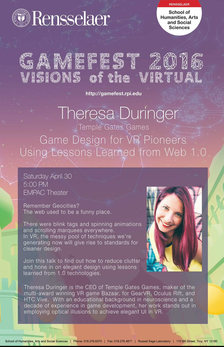 The annual GameFest returns to RPI this weekend with a bunch of demos and talks about video games and their futures, along with an electronic music event. This year's theme is "Visions of the Virtual." The events are free and open to the public.
The annual GameFest returns to RPI this weekend with a bunch of demos and talks about video games and their futures, along with an electronic music event. This year's theme is "Visions of the Virtual." The events are free and open to the public.
Here's some blurbage about the student-created games demo and competition at EMPAC that's part of the fest:
On Saturday, April 30, the GameFest expo, competition and symposium at EMPAC features over 50 student teams from colleges and universities across the Northeast, with a game design competition hosted by Vicarious Visions. Dive into virtual reality and fly a stunt kite, or become a narwhal making sandwiches at a deli counter. Play through a tale of love and loss using your own facial expressions, or explore an immersive environment of freshwater ecology. Check out the future of multiplayer gaming, haptic feedback devices, mobile games and more.
(Aren't we all narwhals making sandwiches at the deli counter of life?)
The schedule also includes Algorave 0x0F -- "an evening of cutting-edge electronic music, interactive visuals, and live-coding performances" -- Friday night at the Tech Valley Center of Gravity. And there will be keynotes and mini talks on Saturday. A condensed schedule is after the jump.
Gather around
EMPAC is often described not just as a collection of performance venues, but also as a research center. And if you've ever wondered what sort of research goes on there (we've been curious) here's one example: a group at EMPAC has created a six-foot-diameter "fire pit" for displaying information to a group of collaborating people.
From the RPI blog The Approach:
The Campfire consists of two main display surfaces, its "wall" and "floor." While they can be largely independent, their shared edge provides a natural interface for various dimensions of visualization, simulation, and interaction. Any traditional two-dimensional images and applications can be placed on the surfaces, but a key innovation is that each of the surfaces has one continuous, potentially shared, dimension. Information can be wrapped around the campfire as in the rings of a tree, the spokes of a wheel, or even in a panoramic view of a real or virtual landscape. The wall can be used to dive into data shown on the floor and vice versa.
The video embedded above provides a short look at how the display in action.
From RPI to the NFL
Here's Andrew Franks' game-tying field goal from Sunday. The Phins went on to win, 17-10. #RPIFB #d3fb #Dolphins pic.twitter.com/hptAw6LmPN
— Perry Laskaris (@PerryLaskaris) September 14, 2015Kicker -- and RPI grad -- Andrew Franks made his NFL debut Sunday with the Miami Dolphins, making a field goal and two extra points. He's the first former RPI player to play in the regular season NFL game. [NFL] [RPI]
As Pete Iorizzo highlighted in the Times Union this past weekend, Franks ended up going to school at RPI because he wanted to major in biomedical engineering -- a choice that some Division I football programs apparently weren't willing to accommodate. [TU+ (link around)]
GameFest 2015
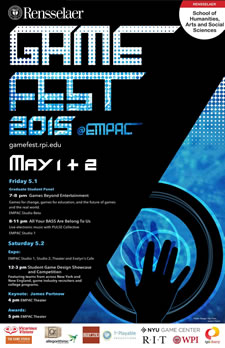 Returning to EMPAC this weekend: GameFest. What is GameFest? Blurbage:
Returning to EMPAC this weekend: GameFest. What is GameFest? Blurbage:
GameFest at Rensselaer is an annual celebration of creativity and innovation in digital games, with a student showcase and competition, music performances, and presentations from veteran game designers, critics, scholars, and indie developers.
Since 2003, GameFest has grown into a regional event that brings together game design students from schools throughout the Northeast, with a competition judged by industry experts. Talks and panels include topics from serious games and entrepreneurship to deep design questions and the democratization of independent game development. Music performances range from music made with repurposed game consoles to an orchestra performing classical arrangements of music from games.
This year's event, which runs Friday evening through Saturday, includes:
+ A discussion about games for purposes beyond entertainment.
+ A concert featuring "game music, chiptunes, livecoding, circuitbending, beats, and interactive visuals from this eclectic collective of DJ's, musicians, and video artists."
+ The game design showcase with work from students from eight colleges and universities.
+ A keynote by James Portnow, "a game designer and consultant known for his theories on socially positive design."
Here's the full schedule. It's free and open to the public.
Jeffrey Tambor at RPI

Actor Jeffrey Tambor will be at EMPAC April 16 for a talk. Tickets for the event are available to RPI students and community members starting March 16 -- they'll be available free to the general public, pending availability, starting April 1 at the EMPAC box office.
Tambor is probably best known for his role on Arrested Development. But over the last year he's gotten a lot attention for his role as the transgender parent on the Amazon show Transparent -- he won the 2015 Golden Globe for best actor for the role (and the show won the award for best TV series).
Tambor's talk is titled "Performing Your Life," which is described as "part one-man show, part seminar, part question-and-answer session, and endlessly entertaining ... This down to earth conversation is about using life experiences to advise others to face their fears, attain their goals, and break out of their shell."
It's very likely this event, which is in the EMPAC concert hall, will fill up. So if you're interested in going, it's a good idea to tickets sooner rather than later. And be sure to check the Rensselaer Union FB page for updates about availability.
photo via American Program Bureau
Garnet Douglass Baltimore, who was "as much of Troy as the monument"
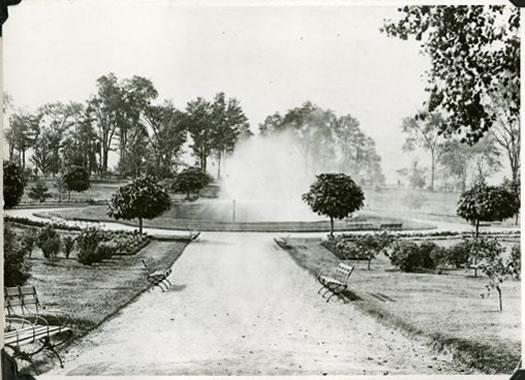
Troy's Prospect Park was designed by Garnet Douglass Baltimore, RPI's first African-American graduate. This photo of the park is from around 1910.
Each Friday this February we've been highlighting people and stories from the Capital Region's history in honor of Black History Month.
Being named for two noted abolitionist heroes could be a little intimidating, but Garnet Douglass Baltimore was equal to his name.
This grandson of an escaped slave grew up to become RPI's first African-American graduate, a civil engineer, landscape architect, and the designer of Troy's Prospect Park.
Won't you guide my sleigh tonight?

From Lighting Research Center at RPI some science to go along with the Rudolph the Red Nosed Reindeer story:
Interestingly, LRC research on perception under headlamp illumination of different colors under inclement weather like blowing snow confirms that the red color of Rudolph's nose was a very fortunate circumstance. LRC researchers John Bullough and Mark Rea measured peoples' ability to perform a driving task while looking through a simulated nighttime snowstorm. The headlights in that study could be red, yellow, white or blue-green, meaning people had to look through visual noise illuminated by different colors while performing the driving task. Performance was best under the red light and worst for the blue-green light. Bullough's and Rea's results showed that the light reflected by blowing snow when driving at night is least distracting when the color is red and that sensitivity to conditions like their simulated snowstorm may be influenced by rod photoreceptors in drivers' eyes, which are more sensitive to "blue" light and less sensitive to "red" light. In other words, the light from Rudolph's red nose could help make rooftops more visible by making blowing snow less visible!
And to think they used to laugh and call him names.
Looking forward to the "Rudolph" setting for the headlights on some future car.
RPI's Shirley Ann Jackson tops rankings of nation's highest-paid private college presidents
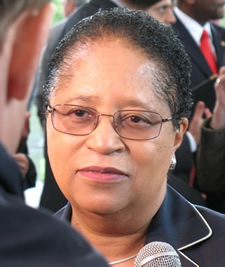 RPI president Shirley Ann Jackson topped the list of the nation's highest paid private college president in 2012, according to an analysis by the Chronicle of Higher Education. Jackson's total compensation -- $7.1 million -- was more than 3.38 million higher than that of the second president on the list.
RPI president Shirley Ann Jackson topped the list of the nation's highest paid private college president in 2012, according to an analysis by the Chronicle of Higher Education. Jackson's total compensation -- $7.1 million -- was more than 3.38 million higher than that of the second president on the list.
Jackson's base pay for 2012 was $945k. The bulk of her compensation came in the form of a deferred compensation payout worth $5.9 million. (One reason why her compensation in 2012 was much higher than the somewhat-over-$1 million range it had been in recent years.)
The Chronicle's website has a detailed breakdown of the numbers for each president. In Jackson's case, her total compensation also ranked third in the nation when calculated as compensation per institution total expenditures. And it ranked in the 99th percentile nationally for base pay to faculty salary ratio.
The Chronicle collected the info from the RPI's Form 990 filing, which all non-profits must file. You can look it up for free over at Guidestar. (The compensation figures are from page 14.)
To go along with the top spot in the compensation ranking, the Chronicle also added a long article looking at Jackson's tenure at RPI. It notes Jackson will likely be remembered as "a trailblazing president, whose unparalleled vision and determination transformed a respectable regional private college into a nationally recognized research institution" -- but it also includes extensive criticism of her, describing "tales of an imperial air and cowed staff." Here's a clip:
Alumnus flyby
A huge shout out to @RPI in Troy, NY from a '97 grad on the #ISS pic.twitter.com/vIjONG0lXG
— Reid Wiseman (@astro_reid) July 6, 2014RPI grad Reid Wiseman is currently on the International Space Station.
It's always nice when alumni stay within orbit of a school.
A miniature version of Troy and its past

Troy's former Union Station as it once was -- and still is, in miniature.
Of all the things you might expect to find in the basement of a college dorm, a meticulously-built recreation of 1950s Troy is probably not one of them.
Yet in the basement of RPI's Davison Hall the Rensselaer Model Railroad Society has been constructing a to-scale version of the city and other spots around the region that were connected by rail. The work has been going on for more than three decades -- and it's a sight to see.
GameFest 2014
 The annual GameFest at RPI -- a series of events focused on video games -- returns this weekend. And the showcase of student-designed games is open to the public. Blurbage:
The annual GameFest at RPI -- a series of events focused on video games -- returns this weekend. And the showcase of student-designed games is open to the public. Blurbage:
The games Rensselaer students will showcase this year are widely varied and include Kajo, a game in which players run and jump their way through a mystical, floating city and use concepts of physics to improve their parkour-style moves. Another game, Space Luddites, features a group of characters fighting back against an oppressive, dystopian future and a powerful company that controls all technology.
The showcase is at EMPAC from noon-3 pm on Saturday. It's free.
The guy who invented the web will be at RPI
 Tim Berners-Lee -- who actually has that line in his CV -- will be getting an honorary degree at RPI's commencement in May. Geneticist Mary-Claire King -- who identified the BRCA1 gene -- will also be getting an honorary degree. And IBM CEO Virginia Rometty will be giving the commencement address.
Tim Berners-Lee -- who actually has that line in his CV -- will be getting an honorary degree at RPI's commencement in May. Geneticist Mary-Claire King -- who identified the BRCA1 gene -- will also be getting an honorary degree. And IBM CEO Virginia Rometty will be giving the commencement address.
All three will be participating in a discussion led by Shirley Jackson -- "Creating Clarity in Complexity to Enable Transformational Change" -- on May 23.
Berners-Lee created the underlying protocols for the web in 1989 while working at CERN, the particle physics lab, in Switzerland. The idea behind it was to make it easier for scientists and researchers at different institutions to share information (though cat pictures were probably a close second reason). CERN had the first website.
As it happens, the actual room -- you know, the physical space -- where the web was invented is actually in France, just over the border. (There's a plaque there now.)
More than a century of RPI, and Troy, online

That time Jim Morrison trolled Troy with reference to Virgil and Homer.
Check it out: More than a century of back issues of the RPI student newspaper, The Polytechnic, have been digitized and placed online. They're now available through RPI's online digital collections portal.
It's usually fun to flip through old newspapers, it's true here, too. Here's one example from the archives, a story we'd heard about before, but the sarcasm of the contemporary account adds something to it. From the December 13, 1967 issue, an article by Bob Cunningham about The Doors playing a concert on campus:
It was concert time again at the Field House Friday night. This show, the opening event of Frosh Fling Weekend, began with typical Rensselaer precision a half-hour late.
Following the opening act, there was a 10 minute intermission which was well received by the crowd. A half-hour later the Doors came on and like true showmen gave not quite their all for 45 minutes. ...
Following Rose was the headline group, the Doors. CRAWDADDY MAGAZINE, New York's rock music bible, describes them as "the best the West has to offer" in concert. The audience was receptive to renditions of their hits "People are Strange" and "Break on Through." Also they were intrigued by the haunting tones of "Alabama Song" (Whisky Bar).
Most people were pleased by Ray Manzarek's organ and Robby Krieger's guitar soaring through "Light My Fire" and a few other songs. Unfortunately, much of the impact and fire of Jim Morrison's vocals seemed to be lost in the expanses of the Field House.
Instead of setting the house on fire, Jim failed to even break the ice. He seemed disgusted with the whole scene at the end and showed how he felt when he cried, "If this is Troy, I'm with the Greeks."
For the crowd's taste, the concert was far too short to be worthwhile. Those on the floor felt cheated of space, and all felt cheated out of the best the Doors could have offered.
The online archive of Poly issues stretches back as far 1869, with the bulk from 1885-2001. It includes more 41,000 pages. (We can't imagine how long that must have taken to scan all of those issues.)
Oh, and among the ads in the collection's first issue, from September 25, 1869: "Charles F. Lucas, Confectioner, Ladies and Gentlemen's Restaurant, No. 12 Broadway, Troy, N.Y."
image: The Polytechnic December 13, 1967, Rensselaer Digital Collections
Beijing in North Greenbush
This caught our eye the other day -- and it struck us both as potentially very cool, and very RPI.
The school is working to re-establish its Mandarin language minor, which makes a lot of sense. Being able to speak Mandarin is a very useful skill for all sorts of careers. And, you know, there are only about a billion people in the world who speak it.
So, how to go about that? Hire some faculty, start some classes, maybe an exchange program. Sure. But RPI is also building a virtual reality environment to mimic Beijing so that students can practice Mandarin in context.
From a write up of the Mandarin Project by Emily Donohue on RPI's Approach blog:
In late November, the first class of students taking Chinese at Rensselaer since efforts began to re-establish the Chinese language minor, stepped into the Mandarin Project's hangar-like space in the [Emergent Reality Lab] for a test-drive.
They took seats at café tables surrounded on three sides by massive screens projecting the image of a Beijing teahouse. Facing the students at the front of the room was a woman - a virtual woman - who would serve as their teacher.
The students donned 3-D glasses, the same kind you'd find at a movie theater, and one student was designated the guide and controlled the experience by wearing a hat studded with ping pong-like balls and holding a video game controller.
The lights dimmed and the students traveled to Beijing.
As Sheldon and Chang looked on, with what seemed like equal parts anxiety and excitement, the students were led through a series of questions by the virtual instructor. She taught them about traditional Chinese tea ceremonies and they had to use their knowledge of Chinese - still fledgling at this early stage of their studies - to interpret her questions and select the correct answer. By doing so, they moved on to the next part of the lesson.
That Approach link has a bunch of photos and more details. And the video embedded above is from the virtual reality session.
Whooooo's that?
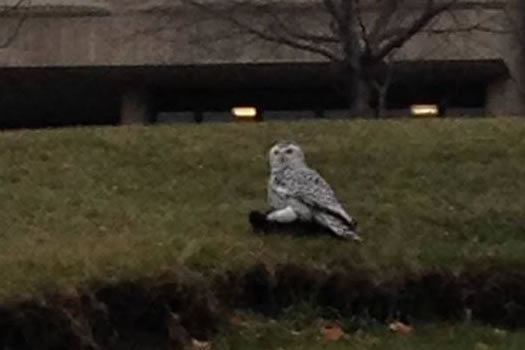
Wait a second, maybe we're just bystanders to an ongoing owl-crow war. That would explain a lot of things...
Spotted in Troy this week: A snowy owl taking down a crow. The photo, by John Cook, is from the RPI campus and was posted on EMPAC's Facebook.
Snowy owls are very cool birds -- but, you know, they don't typically show up here. At least, not traditionally. But for whatever reason, the last two winters have seen snowy owls popping up in all sorts of locations south of their usual range (the Arctic and Canada, in this hemisphere). [USAT] [Chicago Tribune]
So, why is this happening? From the Boston Globe this week:
"We don't know what's going on," said Kevin McGowan, an ornithologist who has spent 25 years at Cornell University's Lab of Ornithology. "There's no clear signal yet."
McGowan said the increased number of sightings could be a signal of something very good -- plentiful food leading to the birth of more of the birds than ever before -- or something very bad, such as climate change curtailing the food supply and forcing more owls to venture south to survive.
The visits have a caused a few problems. At the major NYC-area airport they were blamed for recent collisions with five airplanes, which had prompted the addition of the birds to airport kill lists. But the Port Authority reversed its decision and says it will now be capturing and relocating the owls. [NYDN] [NYT]
The novelty's wearing off

a) all films b) science fiction films c) science fiction films
The chart above is from an interesting new paper about movie theme novelty by RPI researcher Sameet Sreenivasan in the journal Nature Scientific Reports. Sreenivasan used keyword tags from IMDB to track rise and fall and certain themes -- and calculate novelty scores based on the use or combination of those themes -- for films over the last 80 years. That streamgraph chart tracks popular themes over time (here's a bigger version).
Sreenivasan's paper is full of interesting bits and assertions about films over the years. Maybe the biggest one is that novelty in films increased dramatically after the demise of the old-school studio system and has been slowly declining since. This Wired article is a good write up of the study's findings.
Also interesting (to us): Sreenivasan is a physicist -- but he's a research associate at RPI's three-year-old Social and Cognitive Networks Academic Research Center. From a short bio on his web page:
The topics I work on include investigations of peer-influence driven processes on social networks, studies aimed at uncovering community evolution on dynamic networks, mining the hierarchical relationships hidden within crowdsourced keyword sets and devising metrics that quantify novelty from these sets.
Some of the discussion at the end of his film novelty paper point at some of the future applications of this sort of research -- including "artificial or computer-aided story generation."
Oh, and we learned a new word today: culturomics.
graphs: "Quantitative analysis of the evolution of novelty in cinema through crowdsourced keywords," Sameet Sreenivasan, Nature Scientific Reports
Following Stranger Visions
Here's a short TED documentary about the process RPI grad student Heather Dewey-Hagborg uses to create 3-D "portraits" from found DNA. The video is part science talk/part how it's made/park reflection on the near future. Another thing we liked about it is the way it highlights some of the uncertainty in the work, something Dewey-Hagborn readily acknowledges and folds into her thoughts about the project.
[via Colossal)
Earlier on AOA: Stranger Visions
Bacteria from space (OK, they're originally from Earth, but they went to space)
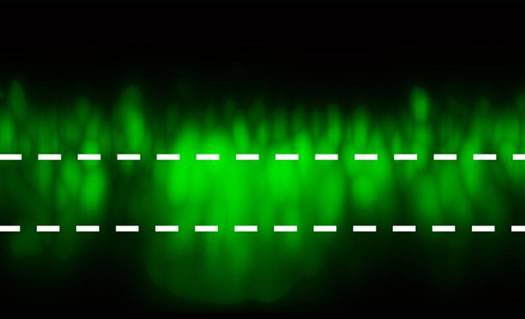
Bacteria were sent into space and they came back glowing green. (OK, not really: these are micrographs of the side view of the unusual structures formed by the bacteria sent into space.)
From the Annals of Didn't This All Go Horribly Wrong in the Movie Version: Researchers from RPI report that bacteria sent into space behave in unusual ways. From an RPI News article:
Recent findings provide important evidence of spaceflight's effect on the behavior of bacterial communities and represent a key step toward understanding and mitigating the risk these bacteria may pose to astronauts during long-term space missions.
The research team, led by Rensselaer faculty member Cynthia Collins, sent the experiment into orbit aboard Atlantis' STS-132 mission in May 2010 and its STS-135 mission in July 2011. Samples of the bacteria Pseudomonas aeruginosa were cultured for three days in artificial urine. The space-grown communities of bacteria, called biofilms, formed a column-and-canopy structure not previously observed on Earth. Additionally, biofilms grown during spaceflight had a greater number of live cells, more biomass, and were thicker than control biofilms grown under normal gravity conditions.
Bad sci-fi jokes aside, this is an interesting topic. Biofilms are common in nature -- That plaque on your teeth? Biofilm. -- and their formation is based on some remarkable bacterial communication (bacteria have been heavily invested in nanotech since, you know, forever). As the RPI article alludes to, biofilms play a role in hospital-acquired infections. In fact, that's probably one of the reasons the researchers picked Pseudomonas aeruginosa -- it's a common hospital infection and is associated with infections from devices such as catheters (yeah, now the urine part is probably making sense, too). A lot of medical devices are already hard to thoroughly clean, and sticky biofilms make the job even harder.
So, sending these microbes into space -- and bringing them back to Troy -- could help scientists better understand how biofilms form. And that, in turn, could help people here on Earth -- or if/when we send people to Mars.
Because spaceships sound kind of germy.
image: Rensselaer Polytechnic Institute
Stranger Visions

Heather Dewey-Hagborg and her self portrait. (photo: Dan Phiffer)
Filed under... well, we're not sure: Heather Dewey-Hagborg -- a PhD student in RPI's electronic arts program -- has been creating 3-D "portraits" based on found DNA. From the statement for "Stranger Visions":
In Stranger Visions artist Heather Dewey-Hagborg creates portrait sculptures from analyses of genetic material collected in public places. Working with the traces strangers unwittingly leave behind, Dewey-Hagborg calls attention to the impulse toward genetic determinism and the potential for a culture of genetic surveillance.
A press release from this March explains how she creates the portraits. The process, boiled down: Dewey-Hagborg collects discarded hair, cigarette butts, and chewing gum. She then takes it back to a lab, extracts DNA from the sample, amplifies certain parts of it, then looks for certain segments that are associated with various physical characteristics. The info then goes through a 3-D modeling program and the portrait is printed on a color 3-D printer.
Her website has a bunch of the portraits, along with photos the samples and where they were collected.
... said KGB about Drawing: What's something that brought you joy this year?